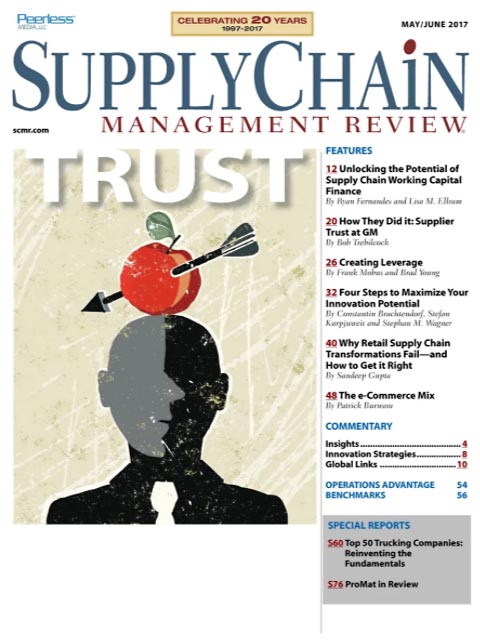Sorry, but your login has failed. Please recheck your login information and resubmit. If your subscription has expired, renew here.
May-June 2017
Trust hasn’t always been an element in supplier relationships; all too often buyers have been encouraged to carry a big stick and get tough with suppliers to get the best price—no matter the cost. That approach to procurement is beginning to change. Browse this issue archive.Need Help? Contact customer service 847-559-7581 More options
Most of us experience the power of leverage for the first time as children on the playground seesaw: Very quickly we learn that if we place the board in the right place over the fulcrum, a small child can easily lift a much larger kid at the other end. But, there is more than just power involved; there is also trust. After all, if the smaller child jumps off the seesaw, it comes crashing down hard.
Leverage, and the power that comes with it, is a critical element of any negotiation. Yet, too many people are tempted to think of leverage as something they either have or they don’t; in other words, they see power as a product of the situation, not as the result of actions they can take. Just like moving the seesaw board forward or backward over the fulcrum to change the dynamic on the playground, there is much either side can do to find, build and develop leverage in any negotiation. By thinking more creatively, negotiators can find a wider range of leverage opportunities. Like most tools, the challenge is to pick the right one for the job: With the right tool, the work gets done faster and with greater success.
When meeting with clients, Mobus Creative Negotiating suggests that there is a spectrum of negotiations that runs from hard bargaining to creative deal making. We also suggest that there is a leverage spectrum. At one end of the spectrum is the consequential leverage that comes from showing the counterparty why they need you: Buyers may point out how important they are to a supplier’s business while presenting the options—or consequences—if the supplier does not cooperate. This is especially the case in one-time or highly contentious transactions.

This complete article is available to subscribers only.
Log in now for full access or start your PLUS+ subscription for instant access.
SC
MR
Sorry, but your login has failed. Please recheck your login information and resubmit. If your subscription has expired, renew here.
May-June 2017
Trust hasn’t always been an element in supplier relationships; all too often buyers have been encouraged to carry a big stick and get tough with suppliers to get the best price—no matter the cost. That approach to… Browse this issue archive. Access your online digital edition. Download a PDF file of the May-June 2017 issue.Most of us experience the power of leverage for the first time as children on the playground seesaw: Very quickly we learn that if we place the board in the right place over the fulcrum, a small child can easily lift a much larger kid at the other end. But, there is more than just power involved; there is also trust. After all, if the smaller child jumps off the seesaw, it comes crashing down hard.
Leverage, and the power that comes with it, is a critical element of any negotiation. Yet, too many people are tempted to think of leverage as something they either have or they don't; in other words, they see power as a product of the situation, not as the result of actions they can take. Just like moving the seesaw board forward or backward over the fulcrum to change the dynamic on the playground, there is much either side can do to find, build and develop leverage in any negotiation. By thinking more creatively, negotiators can find a wider range of leverage opportunities. Like most tools, the challenge is to pick the right one for the job: With the right tool, the work gets done faster and with greater success.
When meeting with clients, Mobus Creative Negotiating suggests that there is a spectrum of negotiations that runs from hard bargaining to creative deal making. We also suggest that there is a leverage spectrum. At one end of the spectrum is the consequential leverage that comes from showing the counterparty why they need you: Buyers may point out how important they are to a supplier's business while presenting the options—or consequences—if the supplier does not cooperate. This is especially the case in one-time or highly contentious transactions.
 SUBSCRIBERS: Click here to download PDF of the full article.
SUBSCRIBERS: Click here to download PDF of the full article.
SC
MR


Latest Supply Chain News
- How S&OP provides the answer to in-demand products
- AI, virtual reality is bringing experiential learning into the modern age
- Humanoid robots’ place in an intralogistics smart robot strategy
- Tips for CIOs to overcome technology talent acquisition troubles
- There is still work to do to achieve supply chain stability
- More News
Latest Podcast

 Explore
Explore
Latest Supply Chain News
- How S&OP provides the answer to in-demand products
- AI, virtual reality is bringing experiential learning into the modern age
- Humanoid robots’ place in an intralogistics smart robot strategy
- Tips for CIOs to overcome technology talent acquisition troubles
- There is still work to do to achieve supply chain stability
- Blooming success: The vital role of S&OE in nurturing global supply chains
- More latest news
Latest Resources

Subscribe

Supply Chain Management Review delivers the best industry content.

Editors’ Picks





